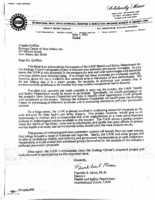Working with Industry: The Auto Project
Alongside working with communities impacted by automotive production and workers employed in the sector, the early 1990s marked a new period of engagement with auto companies, regulators, and environmental advocates to take a systemic approach to eliminating the industry's release of persistent toxins.
Announced amid much fanfare in September 1991, the Auto Industry Pollution Prevention Project (Auto Project) began as a voluntary undertaking between the Michigan Department of Natural Resources and the American Automobile Manufacturers Association. “As a first of its kind partnership, the Auto Project was to allow - in contrast with the traditional regulatory approach - greater flexibility for the automakers to develop pollution prevention strategies which could integrate environmental decision-making into product and process design."
The Ecology Center proposed an advisory panel to help balance the Auto Project's existing membership that prioritized government and industry. This approach, one that the EC hoped would broaden feedback available to executives and officials, sprang from the same impulse of building environmental coalitions that characterized local community and regional engagement. Coming to the table with industry indicated that environmentalism’s tactical handbook was not singularly focused on government regulation, but rather was part of a broader coalition of stakeholders who supported reducing Michigan’s toxic footprint.
So Much Promise, So Little Progress
In 1993, President Bill Clinton announced a clean car initiative that, like the Auto Project, focused on how cars were designed and produced. At that time the Great Lakes-based Auto Project was “still the only public/private effort specifically focused on the environmental impacts from auto manufacturing (6).” After two years of operation, however, a 1993 report by the Ecology Center summed up its findings with a report titled “So Much Promise, So Little Progress.” The EC found that companies had not conducted surveys of pollution and manufacturing processes, few new pollution prevention projects were underway, auto company suppliers (who accounted for the majority of toxic releases) fell outside the agreement’s purview, outside stakeholders lacked opportunities to participate in setting direction, and the project had no clear goals or timetables for eliminating specific persistent toxic substances (Charles Griffith Report).
Since the automotive industry was a major contributor to pollution in the Great Lakes, the EC observed the introduction of systems that streamlined and reduced toxics use would improve the region’s economy by making automotive production more efficient, but also, given the sector’s size, had “the potential to affect the way manufacturing is carried out through the entire country. (ER 25.5, pg. 10)”
Charles Griffith interview - video 0005 - 2:33-10:45; 12:47-21:45
Jeff Gearhart interview - 4:24 - 12:15; GM Plant - 12:34 - 20:43; Ford Plant Dearborn - 21:00-23:46 [might be more in 2000s]
The Great Lakes Auto Pollution Prevention Alliance
To build and sustain pressure on the Auto Project to take environmental questions seriously, the Ecology Center formed a coalition of environmental and community groups called the Great Lakes Auto Pollution Prevention Alliance. Union leadership and agreed with the EC that “additional groups be involved in the analysis of the industry’s pollution prevention proposals. (Bentley, Ecology Center Records, Box 21, Franklin Mirer to Charles Griffith, May 1 1992)” The EC began conducting research and assisting citizens in assessing pollution prevention activities at local auto plants. Since local plant management made many decisions regarding the use and release of toxics, GLAPPA advocated that role of local citizens in promoting pollution prevention at these plants. In Minneapolis, a local group - Citizens for a Better Environment – brought together community members, union representatives, and local elected officials in “calling for a meeting with managers from a Ford assembly plant to discuss their pollution prevention efforts. Ultimately, successful implementation of Pollution Prevention will probably require concerned pressure on both [the local and the national] levels. (ER 26.3, pg. 4)”
In the summer of 1994, the EC newsletter reaffirmed the organizations commitment that a vocal and engaged environmental coalition was essential to ensuring the accountability and ultimate success of the Auto Project. The ongoing challenge, was the “development of a meaningful public involvement process for the project” that could hold Michigan’s Department of Natural Resources and the Big Three Ford, GM, and Chrysler to account. Part of that activity focused on the Common Sense Initiative, a consensus-based multi-stakeholder EPA undertaking that the EC joined as part of the Auto Manufacturing national committee. With analogies to the Auto Project’s systemic approach to manufacturing, the CSI aimed and “finding cleaner, cheaper, and smarter approaches to environmental regulation” that looked at industry sectors as a whole (ER 29.2, pg. 4).
Successes of the EC’s focus on automotive pollution included working with a coalition of community groups in Dearborn in the spring of 1998 to lobby Ford to install a water-based state-of-the-art painting process that reduced worker hazards and air pollution. A Partnership for Regulatory Innovation and Sustainable Manufacturing project developed between the EC, General Motors, and other environmental organizations promoted efficiencies in production and campaigns with community groups in Lansing, Westland, and Pontiac and working with plant officials and promoting more effective state and federal policies.
Going Global
in 1999 the Auto Project went global. Unrolling new projects promoting “advanced, clean” vehicles and on strategies to hold industry and government accountable for real progress in reducing automobile-related pollution that acknowledged the global circuits of automotive manufacturing. Wearing a multitude of hats as critic, watchdog, and advisor, the overall goal of the Ecology Center’s engagement with the Auto Project was to maintain accountability. While the origins of the Auto Project were regional, an expanded global remit and focus on consumer, producer, and regulatory behaviors would come to fruition in the new century


